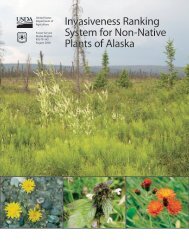mouse-ear hawkweed Hieracium pilosella L. - Alaska Natural ...
mouse-ear hawkweed Hieracium pilosella L. - Alaska Natural ...
mouse-ear hawkweed Hieracium pilosella L. - Alaska Natural ...
- No tags were found...
You also want an ePaper? Increase the reach of your titles
YUMPU automatically turns print PDFs into web optimized ePapers that Google loves.
disturbed areas, sand, gravel, fields, lawns, androadsides (Strother 2006, Klinkenberg 2010). It is aweed of pastures in North America and New Zealand(Davy and Bishop 1984, Piening and Russo 1988, Scottet al. 1990).Native and current distribution: Mouse-<strong>ear</strong> <strong>hawkweed</strong>is native to Europe (Piening and Russo 1988, Strother2006). It was introduced to North America and NewZealand in the <strong>ear</strong>ly 20 th century (Piening and Russo1988). This species grows in 23 states of the U.S. in thePacific Northwest and eastern U.S. (Strother 2006,USDA 2011). It has also been introduced to SouthAmerica (Cipriotti et al. 2010). Mouse-<strong>ear</strong> <strong>hawkweed</strong>grows as far north as 67.9°N in Norway (NorwegianSpecies Observation Service 2011). It has beendocumented from Girdwood and Prince of Wales Islandin the Pacific Maritime ecogeographic region of <strong>Alaska</strong>and Kenai in the Interior-Boreal ecogeographic region(AKEPIC 2011, UAM 2011).Pacific MaritimeInterior-BorealArctic-AlpineCollection SiteManagementThe addition of nitrogen, potassium, and phosphorus tograsslands increases populations of native grasses andreduces or eliminates populations of <strong>mouse</strong>-<strong>ear</strong><strong>hawkweed</strong>. Increased nutrient levels stimulateflowering, which increases the turnover of rosettes sinceparent plants die after flowering (Davy and Bishop1984). Mouse-<strong>ear</strong> <strong>hawkweed</strong> can be controlled by theapplication of 2, 4-D ester at 1,000 g/ha combined withclopyralid at 400 g/ha (Piening and Russo 1988).Aminopyralid at 105 grams per hectare and clopyralid at420 grams per hectare consistently controlled orange<strong>hawkweed</strong> (<strong>Hieracium</strong> aurantiacum) infestations insouthern <strong>Alaska</strong> and may provide effective control of<strong>mouse</strong>-<strong>ear</strong> <strong>hawkweed</strong> as well. Aminopyralid is bettersuited to pasture habitats as it controls a broaderspectrum of forbs than clopyralid, while clopyralid isbetter suited to natural habitats as it will remove less ofthe native vegetation (Seefeldt and Conn 2010).Mechanical control efforts have not been investigated;however, similar to orange <strong>hawkweed</strong>, mechanicalcontrol efforts are likely ineffective. Mouse-<strong>ear</strong><strong>hawkweed</strong> can resprout from root and stolon fragments(King County 2010); for this reason, tilling is notrecommended.Distribution of <strong>mouse</strong>-<strong>ear</strong> <strong>hawkweed</strong> in <strong>Alaska</strong>References:AKEPIC database. <strong>Alaska</strong> Exotic Plant InformationCl<strong>ear</strong>inghouse Database. 2011. Available:http://akweeds.uaa.alaska.edu/Cipriotti, P., R. Rauber, M. Collantes, K. Braun, and C.Escartín. 2010. <strong>Hieracium</strong> <strong>pilosella</strong> invasion inthe Tierra del Fuego steppe, SouthernPatagonia. Biological Invasions. 12(8). 2523-2535 p.Davy, A., and G. Bishop. 1984. Response of <strong>Hieracium</strong><strong>pilosella</strong> in Breckland grass-heath to inorganicnutrients. Journal of Ecology. 72(1). 319-330 p.eFloras. 2008. Published on the Internethttp://www.efloras.org [accessed 22 September2010]. Missouri Botanical Garden, St. Louis,MO & Harvard University Herbaria,Cambridge, MA.Gaskin, J., and L. Wilson. 2007. PhylogeneticRelationships Among Native and <strong>Natural</strong>ized<strong>Hieracium</strong> (Asteraceae) in Canada and theUnited States Based on Plastid DNASequences. Systematic Botany. 32(2). 478-485p.Giroday, H., and V. Baker. 2006. Invasive <strong>hawkweed</strong>s(<strong>Hieracium</strong> ssp.) in Northeastern BritishColumbia. Invasive Plants Program, RangeBranch, British Columbia Ministry of Forestsand Range. Prince George, BC. [6 February2011]http://www.for.gov.bc.ca/hra/Publications/invasive_plants/HawkweeedRiskAssessmentforNortheastBC_FINAL_24Oct06.pdfInvaders Database System. 2011. University ofMontana. Missoula, MT.http://invader.dbs.umt.edu/King County. 2010. Best Management Practices,Hawkweeds, <strong>Hieracium</strong> spp. Noxious WeedControl Board, King County. [17 January 2011]http://your.kingcounty.gov/dnrp/library/waterand-land/weeds/BMPs/<strong>hawkweed</strong>-control.pdfKlinkenberg, B. (Editor) 2010. <strong>Hieracium</strong> <strong>pilosella</strong> L.In: E-Flora BC: Electronic Atlas of the Plantsof British Columbia. Lab for Advanced SpatialAnalysis, Department of Geography, Universityof British Columbia. Vancouver, BC. [17January 2011] Available:http://www.geog.ubc.ca/biodiversity/eflora/index.shtmlMakepeace, W. 1985. Growth, reproduction, andLast Updated: 2011-01-23 by Timm Nawrockihttp://aknhp.uaa.alaska.edu
















